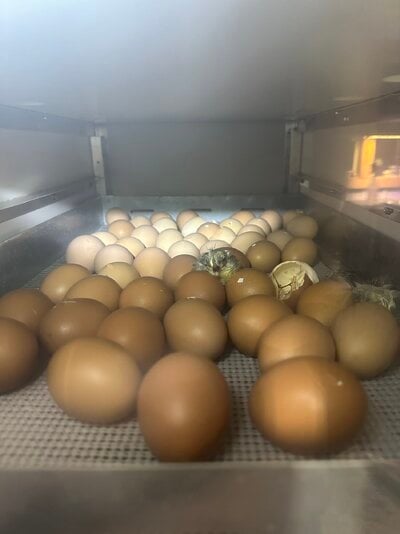- Thread starter
- #11
Ashleyboz
Songster
- Oct 27, 2023
- 157
- 185
- 126
I’m finding with these chicks I can definitely pick out the males and that is because of certain colors, size, and demeanors are so apparent. After having a career in the oilfield and now stay home with the kids I have a lot more time on my hands to watch chickens run aroundI definitely agree with that!
Just to check: the ISA Browns are mostly brown (or red/gold color), with a white tail and some bits of white in other areas, right?
(If I am wrong about that, then what I am about to say will be wrong too.)
Paints could probably come from Smoky Pearls or from ISA Browns.
Paint should be a genetically black chicken, with the Dominant White gene turning the black to white (but missing some bits, which is why they are paint rather than actual white.)
Smoky Pearl and ISA Brown should each have Dominant White (one copy of Dominant White, one copy of the normal gene that allows black to show.) This would mean half their chicks inherit Dominant White, and the other half do not.
The rooster should give genes to make all-black chicks (possibly with some leakage, but I'll ignore that for a minute.)
So your rooster, with either Smoky Pearl or ISA Brown hens, should give about 50% black chicks and about 50% paint chicks.
Leakage: you are more likely to see leakage of red/brown/gold on chicks from the ISA Brown hens, and less likely to see that kind of leakage on chicks from the Smoky Pearl hens. There will probably not be enough difference to be positive which is the mother, just a general likelihood.
Other traits: Chicks from ISA Brown or Smoky Pearl should have the same comb types, amount of leg feathering, leg color(s), crest or lack of it, muff/beard or lack of it, and so forth. When they grow up all the way, there may be differences in body shape and earlobe color, but they may not be enough different to be obvious.
So unless you can be sure of which eggs you are setting, I don't know of any good way to distinguish which chicks come from which of those two breeds.
Those might be male/female differences, based on the rooster having dark skin and either of the possible mother breeds having light skin.
Males are more likely to have leakage like that on their wings and back, and females are less likely to. Yes, I do think that one is more likely to have and ISA Brown mother rather than a Smoky Pearl mother, but I can't be positive.
I was trying to pick out which egg was to which chicken and watch when they hatched but I found the color was pretty inconsistent. I may have went a little overboard with my excitement of hatching and wasn’t scared to use up the space in the hatcher






